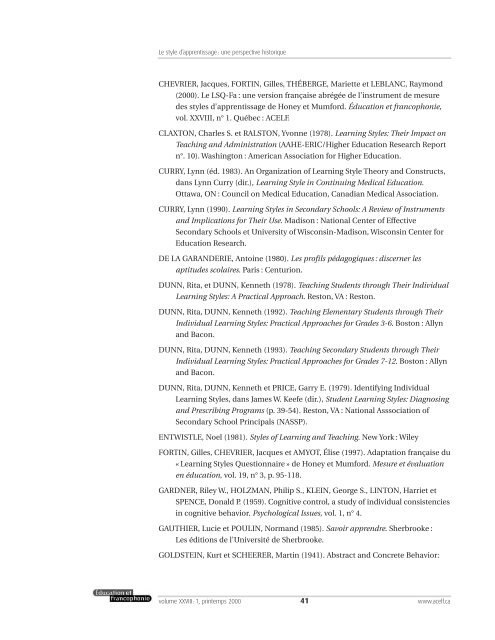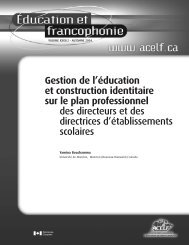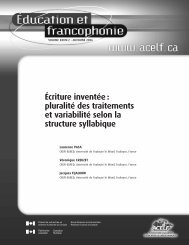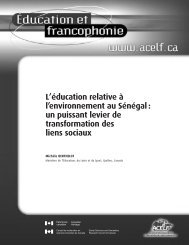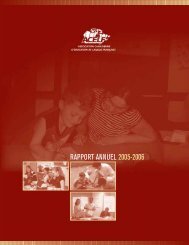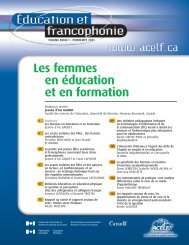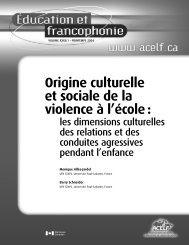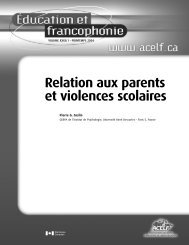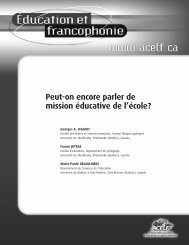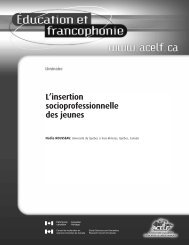Create successful ePaper yourself
Turn your PDF publications into a flip-book with our unique Google optimized e-Paper software.
<strong>Le</strong> <strong>style</strong> d’apprentissage : une perspective historiqueCHEVRIER, Jacques, FORTIN, Gilles, THÉBERGE, Mariette et LEBLANC, Raymond(2000). <strong>Le</strong> LSQ-Fa : une version française abrégée de l’instrument de mesuredes <strong>style</strong>s d’apprentissage de Honey et Mumford. Éducation et francophonie,vol. XXVIII, n° 1. Québec : ACELF.CLAXTON, Charles S. et RALSTON, Yvonne (1978). <strong>Le</strong>arning Styles: Their Impact onTeaching and Administration (AAHE-ERIC/Higher Education Research Reportn°. 10). Washington : American Association for Higher Education.CURRY, Lynn (éd. 1983). An Organization of <strong>Le</strong>arning Style Theory and Constructs,dans Lynn Curry (dir.), <strong>Le</strong>arning Style in Continuing Medical Education.Ottawa, ON : Council on Medical Education, Canadian Medical Association.CURRY, Lynn (1990). <strong>Le</strong>arning Styles in Secondary Schools: A Review of Instrumentsand Implications for Their Use. Madison : National Center of EffectiveSecondary Schools et University of Wisconsin-Madison, Wisconsin Center forEducation Research.DE LA GARANDERIE, Antoine (1980). <strong>Le</strong>s profils pédagogiques : discerner lesaptitudes scolaires. Paris : Centurion.DUNN, Rita, et DUNN, Kenneth (1978). Teaching Students through Their Individual<strong>Le</strong>arning Styles: A Practical Approach. Reston, VA : Reston.DUNN, Rita, DUNN, Kenneth (1992). Teaching Elementary Students through TheirIndividual <strong>Le</strong>arning Styles: Practical Approaches for Grades 3-6. Boston : Allynand Bacon.DUNN, Rita, DUNN, Kenneth (1993). Teaching Secondary Students through TheirIndividual <strong>Le</strong>arning Styles: Practical Approaches for Grades 7-12. Boston : Allynand Bacon.DUNN, Rita, DUNN, Kenneth et PRICE, Garry E. (1979). Identifying Individual<strong>Le</strong>arning Styles, dans James W. Keefe (dir.), Student <strong>Le</strong>arning Styles: Diagnosingand Prescribing Programs (p. 39-54). Reston, VA : National Asssociation ofSecondary School Principals (NASSP).ENTWISTLE, Noel (1981). Styles of <strong>Le</strong>arning and Teaching. New York : WileyFORTIN, Gilles, CHEVRIER, Jacques et AMYOT, Élise (1997). Adaptation française du« <strong>Le</strong>arning Styles Questionnaire » de Honey et Mumford. Mesure et évaluationen éducation, vol. 19, n° 3, p. 95-118.GARDNER, Riley W., HOLZMAN, Philip S., KLEIN, George S., LINTON, Harriet etSPENCE, Donald P. (1959). Cognitive control, a study of individual consistenciesin cognitive behavior. Psychological Issues, vol. 1, n° 4.GAUTHIER, Lucie et POULIN, Normand (1985). Savoir apprendre. Sherbrooke :<strong>Le</strong>s éditions de l’Université de Sherbrooke.GOLDSTEIN, Kurt et SCHEERER, Martin (1941). Abstract and Concrete Behavior:volume XXVIII : 1, printemps 200041www.<strong>acelf</strong>.ca


